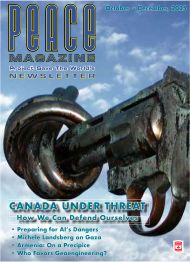Making a Case for Global No First Use of Nuclear Weapons
Debalina Ghoshal, a writer for India’s Defence Service, gives the reader unique insight into why nuclear deterrence is not a guarantee to a country’s security and why there should be a global policy stipulating No First Use of Nuclear Weapons.
Nuclear weapons are here to stay. Nuclear disarmament has become a utopian dream, and probably now, a coveted one too. States are engaged in legal agreements and informal bindings that can enable them to restrict their nuclear weapons development. Non-proliferation mechanisms could make nuclear weapons more difficult to attain for many states. Such agreements and mechanisms, no doubt, have loopholes, and hence, their lack of foolproof approaches attaches several limitations to them. With several limitations to legally binding agreements and arms control regimes, one other way considered logical for achieving disarmament is to adopt a ‘Global NoFirst Use’ policy of nuclear weapons.
EXISTENTIAL CHALLENGES
The policy implies that all states possessing nuclear weapons will accept a universal doctrine of ‘Global NoFirst Use’ rather than myriad doctrines like ‘first-use’, ‘preventive strike’, and ‘pre-emptive strike.’ This policy is a need of the hour considering nuclear weapons, which have become the first line of defence should a state possessing such weapons feel the ‘red lines’ are defied by adversaries.“This policy is a need of the hour considering nuclear weapons”
States like China and India have adopted a ‘No-First Use’ policy in their nuclear doctrine, while China also shares a bilateral ‘no-first use’ policy with Russia that does not follow a strict ‘no-first use’ principle. Thus, adopting a ‘no-first use’ principle is not a cumbersome task. Nevertheless, states adopting such policies do not do so with the intention of pursuing nuclear disarmament. States adopt ‘no-first use’ policies to strengthen their nuclear doctrine by keeping the nuclear threshold high and upholding the philosophy that nuclear weapons are not meant for war-fighting.
Hence, states are working towards strengthening nuclear postures that would enable them to pursue a ‘nofirst use’ policy rather than looking for ways to disarm. Both India and China do believe in the principle of nuclear disarmament and are working towards such goals, but these are not through deterrence posturing. The deterrence posturing is for strengthening both conventional and nuclear deterrence vis-à-vis adversaries. In fact, China and India’s ‘no-first use’ focuses on the survivability of their nuclear arsenals so as to reduce the ‘use them or lose them’ dilemma and strengthen conventional deterrence. The philosophy of ‘nofirst use’ is to reduce, but not abandon, the reliance on nuclear weapons for war-fighting and rely on conventional means of warfare.
Solely because the reason to reduce, but not abandon, nuclear weapons exists, states have focused on making their nuclear weapons more credible. Credibility means that nuclear weapons are capable of launching at least a cataclysmic strike if not a ‘first strike.’ States focus on mobility of their nuclear delivery platforms, hardening of storage facilities, dispersal of both delivery platforms and command and control, and developing technologies like air and missile defence systems that would deny adversaries the ability to strike the state’s nuclear facilities. They also develop technologies like counter-measures on delivery systems that could enable them to defy adversaries’ defenses by denial capabilities and launch devastating strikes. States constantly test their delivery systems to make them operationally ready, though warheads are de-mated from delivery systems. States could also choose to ‘hot launch’ or ‘cold launch’ missile systems as delivery systems that can form the backbone for nuclear deterrence, depending on their launching policies—with the former often being a choice for states with Launch On Warning (LOW) and the latter for states choosing Launch Under Attack (LUA).“The philosophy of ‘no-first use’ is to reduce, but not abandon, the reliance on nuclear weapons for war-fighting and rely on conventional means of warfare.”
These are ways states strengthen their deterrence to make their ‘no-first use’ doctrine more leveled up in the deterrence game. The logic is: “I am not willing to take it to the nuclear level, so I am working hard to ensure I do not do it, but I have capabilities to ensure I can exert my nuclear bullying and dominance across.”
The stability that is created in the region is not because of states looking at ‘no-first use’ as a precursor for disarmament. In fact, adopting a ‘no-first use’ policy is an expensive investment because the state will not be the first one to use nuclear weapons, but could always be the first one to strike with nuclear weapons if its launch LOW or LUA mechanisms are perfectly integrated with its delivery systems.
Hence, stability is created because states have kept their warheads in a de-mated state and adopted all other mechanisms that could keep the nuclear threshold high, enabling them to launch strikes only if necessary, but not to completely abandon the philosophy of using them. In fact, in crisis situations, such states would keep their nuclear weapons in ready deterrent postures that would require greater integration and cooperation to shift from a recessed deterrence posture to a ready deterrence one.
Thus, no doubt, ‘global no-first use’ is viewed as a first step for nuclear weapon states to achieve nuclear disarmament, but most nuclear weapon states would not wish to comply with such ambitions that undermine their peace rather than strengthen it. Nuclear weapons are viewed as ‘weapons of peace.’ Despite catastrophic crises across the globe, the global order has not used such weapons. Hence, most nuclear weapon states would justify their nuclear doctrines on the basis of refraining from using such weapons in crises situations in line with their military aspirations and foreign policy objectives. States would only adopt a ‘global no-first use’ doctrine in their military strategy if it is conducive to their military actions.
States like China and India also have conditions attached to the ‘nofirst use’ doctrine. These conditions include the use of nuclear weapons in territories considered to be their own (China) and the use of nuclear weapons against the use of biological and chemical weapons by adversaries (India). Hence, states adopting ‘nofirst use’ would have several conditions attached that would negate the possibilities of transgressing from a ‘no-first use’ doctrine to a process of disarming such weapons. When conditions are attached to a process of attaining peace, the process becomes cumbersome to achieve its purpose.
Another problem of ‘global no-first use’ is latent states and their nuclear weapons. It will become difficult for the international order to ensure that states like Israel and Iran, which are believed to have nuclear capabilities, adopt a ‘no-first use’ doctrine. States that provide security assurances through nuclear deterrence to other states could find adopting such policies challenging. For instance, the United States could find it difficult to adopt a ‘global no-first use’ policy as it provides nuclear security guarantees to states in East Asia like Japan and South Korea—not only to counter the Chinese threat but also the threat from North Korea’s nuclear blackmail. Under such circumstances, adopting a ‘no-first use’ doctrine could lead to satellite states resorting to their own nuclear weapons.
HOW TO ACHIEVE NUCLEAR DISARMAMENT THROUGH GLOBAL NO-FIRST USE
Strengthen mechanisms that work on the emotional intelligence of state leaders rather than their IQ when dealing with nuclear weapons. This can be done by:
- Leaders unlearning the belief that nuclear weapons could achieve peace and strengthen deterrence.
- Restricting development of dual-use weapons—that is, weapons that could be inducted and deployed for both conventional and nuclear roles. Even if such weapons have been inducted, they should not be deployed unless there is a crisis situation. All states must draw a distinction between induction and deployment to clarify their deterrence postures to adversaries.
- Reducing the role of conventional weapons in conventional war-fighting. States are resorting to conventional war-fighting under the nuclear shadow. This gives global leaders a justification to eulogize nuclear weapons as weapons of peace. Present circumstances highlight that deadly conventional weapons are causing destruction and mayhem, posing a serious threat to mankind. Even though nuclear weapons are not being used, humanity remains endangered.
- Instilling in global leaders the duty to protect mankind and other living beings crucial to maintaining ecological balance.
- Strengthening—and not undermining—the role and importance of sanity in the deterrence game. Global leaders could analyze the number of times they refrained from using nuclear weapons even in crisis situations to conclude that such restraint prevailed due to the destructive capabilities of modern conventional weapons rather than nuclear deterrence.
Thus, the role of nuclear weapons to strengthen deterrence should not dominate the narrative of global security and strategic stability. Disarmament involves abandoning a category of hard power considered the ultimate guarantor of security. Soft-power diplomacy, rather than hard-power coercion, could make these tasks easier and make humankind and the environment—the two most important constituents of the global order—less vulnerable.



